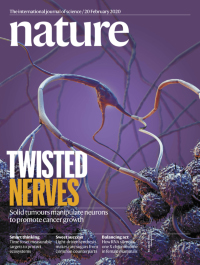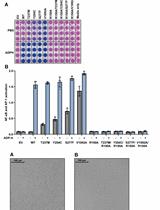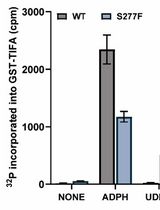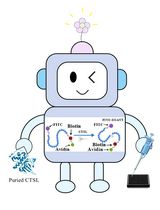- EN - English
- CN - 中文
Polyamine Transport Assay Using Reconstituted Yeast Membranes
利用重构酵母细胞膜的多胺转运实验
发布: 2021年01月20日第11卷第2期 DOI: 10.21769/BioProtoc.3888 浏览次数: 4314
评审: Andrea PuharJoyce ChiuPetru-Iulian Trasnea
Abstract
ATP13A2/PARK9 is a late endo-/lysosomal P5B transport ATPase that is associated with several neurodegenerative disorders. We recently characterized ATP13A2 as a lysosomal polyamine exporter, which sheds light on the molecular identity of the unknown mammalian polyamine transport system. Here, we describe step by step a protocol to measure radiolabeled polyamine transport in reconstituted vesicles from yeast cells overexpressing human ATP13A2. This protocol was developed as part of our recent publication (van Veen et al., 2020) and will be useful for characterizing the transport function of other putative polyamine transporters, such as isoforms of the P5B transport ATPases.
Keywords: Polyamine (多胺)Background
ATP13A2/PARK9 encodes a ubiquitously expressed late endo-/lysosomal membrane protein that is implicated in a spectrum of neurodegenerative disorders, like early-onset Parkinson’s disease (Di Fonzo et al., 2007; Lin et al., 2008) and Kufor-Rakeb syndrome (an early-onset parkinsonism with dementia) (Ramirez et al., 2006; Park et al., 2011). ATP13A2 belongs to the P-type transport ATPases, a family of active transporters that transiently form a phospho-intermediate as a consequence of ATP hydrolysis (Kuhlbrandt, 2004). ATP13A2 is a member of the P5 subfamily, which was identified by genome sequencing more than twenty years ago (Axelsen and Palmgren, 1998) and contains five human isoforms (ATP13A1-5). However, the transported substrate of ATP13A2 remained unknown until recently, when we characterized ATP13A2 as a lysosomal polyamine exporter that shows the highest affinity for spermine (SPM) (van Veen et al., 2020). ATP13A2 is activated by two regulatory lipids, phosphatidic acid and phosphatidylinositol(3,5)bisphosphate (Holemans et al., 2015; van Veen et al., 2020). To prove that ATP13A2 transports polyamines over the membrane, we developed a transport assay using tritium-labelled SPM ([3H]-SPM) and yeast membrane-derived vesicles recombinantly expressing human ATP13A2 with C-terminal BAD (biotin acceptor domain) tag (ATP13A2-BAD).
The polyamine transport assay starts with the production of reconstituted vesicles from solubilized yeast membranes that contain overexpressed ATP13A2-BAD, in the presence of the lipids phosphatidylcholine and phosphatidic acid. The generated proteoliposomes will contain both right-side-out and inside-out oriented reconstituted ATP13A2 (Figure 1), and we made use of this principle to set up a transport assay where we follow the luminal accumulation of [3H]-SPM in the vesicles. Since ATP13A2 is a lysosomal exporter, ATP13A2 should be inserted inside-out (cytosolic domains facing the lumen) to allow luminal accumulation of [3H]-SPM. In this orientation, the lumen of the proteoliposomes should be supplemented with ATP to ensure that ATP binding and ATPase activity can occur at the nucleotide-binding domain. Therefore, we reconstitute the proteoliposomes in the presence of ATP and an ATP regenerating system (phosphocreatine/creatine phosphokinase). In the inside-out orientation, ATP13A2 will promote the uptake of [3H]-SPM in the proteoliposomes if ATP is present inside, in line with ATP13A2-mediated polyamine transport from the extra-cytosol to the cytosol in a cellular context (Figure 1).

Figure 1. Graphical representation of the principle behind the polyamine transport assay. To assay polyamine transport, we use proteoliposome vesicles, reconstituted from yeast membranes that contain ATP13A2. The generated proteoliposomes will contain both right-side-out and inside-out oriented reconstituted ATP13A2. To allow luminal accumulation of [3H]-SPM, ATP13A2 should be inserted inside-out (cytosolic domains facing the lumen) as ATP13A2 is a lysosomal exporter. In addition, the lumen of the proteoliposomes should be supplemented with ATP as in P-type ATPases, ATP binding occurs at a nucleotide-binding site located in one of the cytosolic domains. Only when ATP is present inside the proteoliposomes, [3H]-SPM accumulates within the vesicles, in line with ATP13A2’s cellular role as a lysosomal polyamine exporter.
Our protocol using yeast-derived membranes offers several advantages for the polyamine transport analysis as compared to mammalian systems (e.g., Uemura and Gerner, 2011). Although the preparation of yeast crude extract is more laborious and time-consuming compared to mammalian cell lysis, the benefit lies in the fact that yeast cells grow fast and are easy to culture with low cost and high yield of biomass. Moreover, yeast is a malleable model organism that is easily genetically manipulated. Furthermore, our protocol represents a clean in vitro technique as opposed to a cellular polyamine uptake assay. Our polyamine transport assay is applicable for other candidate polyamine transporters, which will help to establish the molecular players of the mammalian polyamine transport system, which remain largely unknown. Based on the high conservation of the substrate binding domain in the transmembrane helix M4, it is very likely that other mammalian P5B ATPases (ATP13A3-5) also play a role in the polyamine transport system, possibly with a slightly different substrate specificity, subcellular localization and/or tissue distribution. Therefore, our transport assay will also be valuable for characterizing the transport function of the other related P5B ATPases.
Materials and Reagents
Notes:
All materials and reagents are kept at room temperature unless otherwise described. For the shelf life and storage temperature of reagents, we refer directly to the manufacturer’s instructions.
Equivalent materials and reagents of other companies might also be suitable.
Pipette tips
P10 tips (Sarstedt, catalog number: 70.1130.20 )
P200 tips (Sarstedt, catalog number: 70.760.102 )
P1000 tips (VWR, catalog number: 613-0738 )
Filter pipette tips
P10 filter tips (Greiner, catalog number: 771288 )
P200 filter tips (Greiner, catalog number: 739288 )
P1000 filter tips (Greiner, catalog number: 740288 )
Eppendorf tubes (Greiner, catalog number: 616201 )
Falcon tubes (Greiner, catalog numbers: 188271 [15 ml], 227261 [50 ml])
Nitrile gloves (VWR, catalog number: 112-2371 )
Duran glass bottle (VWR, catalog numbers: 215-1516 [500 ml], 215-1517 [1,000 ml] )
Culture flasks (DWK Life Sciences, catalog number: 217715407 )
Syringe-driven filter unit (Merck, Millex, catalog number: SLGS033SB )
Petri dishes (60 mm) (ThermoFisher, catalog number: 123-17 )
Bottle top vacuum filtration system (VWR, complete filtration unit with 0.2 µm pore size, catalog number: 514-0334 )
Acid-washed glass beads (Sigma-Aldrich, catalog number: G8772 )
Test tubes Soda glass (VWR, catalog number: 212-0013 )
Membrane filters, 0.45 μm pore size (Millipore, catalog number: HAWP02500 )
Saccharomyces cerevisiae strain W303-1B/Gal4-∆Pep4 (leu2-3, his3-11,15, trp1-1::TRP1-GAL10-GAL4, ura3-1, ade2-1, canr, cir+, ∆Pep4 MATα)
Note: Strain available from corresponding author upon request.
Plasmid DNA
We use a pYeDP60 vector (with 2-μm circle replication origin, URA3 and ADE2 selection markers, and a galactose inducible promoter) containing a yeast codon-optimized version of human ATP13A2 variant 2 cDNA followed by a thrombin cleavage site and a C-terminal BAD tag (Jidenko et al., 2006; Azouaoui et al., 2014) (Figure 2). In our experiments, we use a catalytically inactive ATP13A2 variant, namely the E343A mutant (van Veen et al., 2020), as a negative transport control. E343 is positioned in the catalytic site for dephosphorylation, which is highly conserved among P-type ATPases (341TGES motif in human ATP13A2 isoform 2).
Note: Plasmids available from corresponding author upon request.
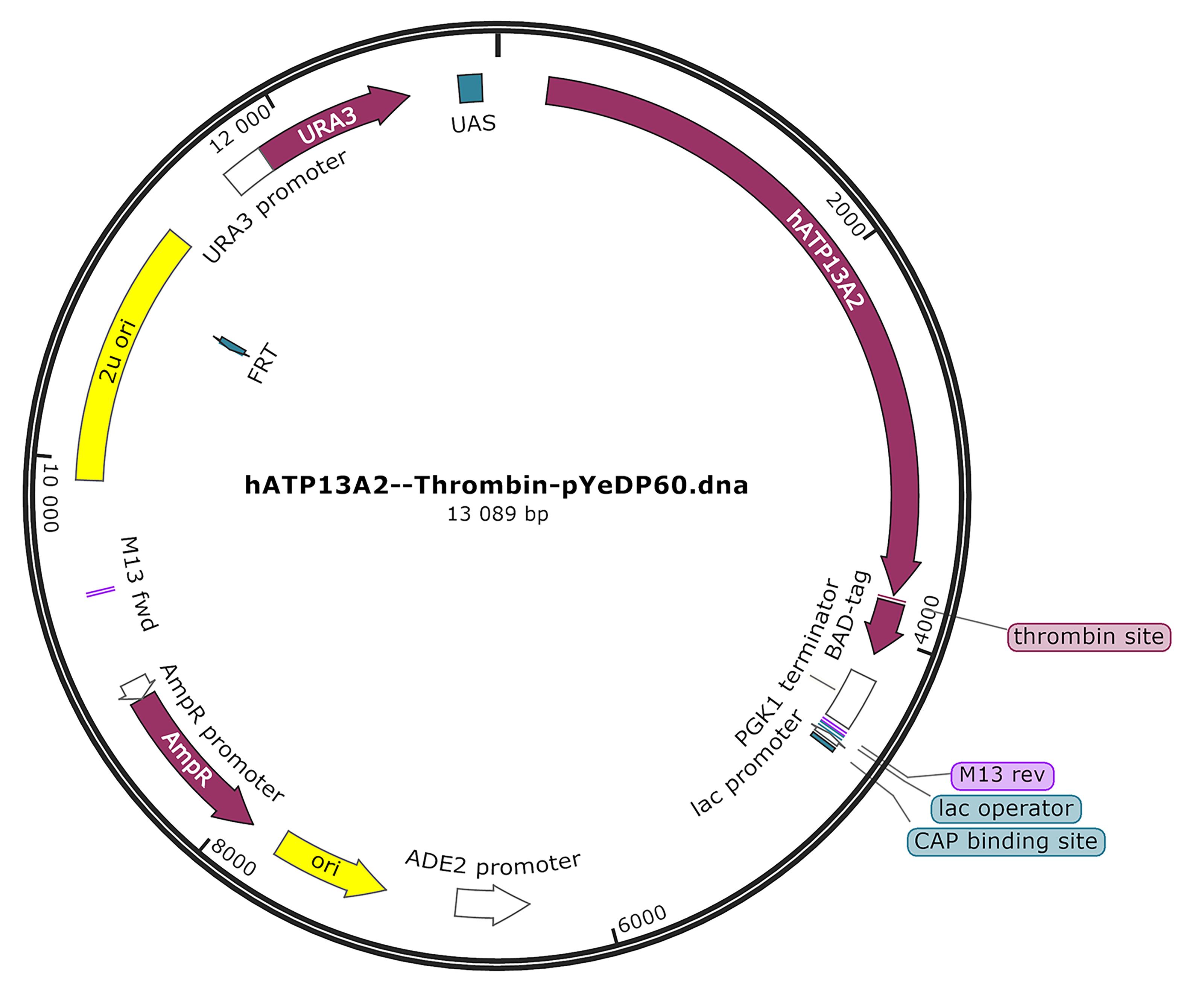
Figure 2. Schematic representation of the ATP13A2 expression plasmid map. The expression plasmid for ATP13A2 is a modified pYeDP60 plasmid. The pYeDP60 vector contains the 2-μm circle replication origin, the URA3 and ADE2 selection markers, a galactose inducible GAL10/CYC1 promoter, multiple cloning sites, and the PGK1 terminator. The human ATP13A2 gene was cloned into the plasmid with a thrombin cleavable BAD (biotin acceptor domain)-tag (Jidenko et al., 2006; Azouaoui et al., 2014).Yeast extract granulated (Merck, catalog number: 1.03753.0500 )
Peptone from casein (Tryptone) (Merck, catalog number: 1.07213.2500 )
D-(+)-Glucose (Sigma-Aldrich, catalog number: G8270 )
Cuvettes (VWR, catalog number: 634-0676 )
Tris base (Sigma-Aldrich, Trizma base, catalog number: T1503 )
Ethylenediaminetetra-acetic acid (EDTA) (BDH Laboratory Supplies, catalog number: 280214S )
Hydrochloric acid (HCl) fuming 37% (Merck, catalog number: 1.00317.2501 )
HCl 0.5 N (Reagecon, catalog number: H20501 )
Lithium acetate dihydrate (LiAc) (Sigma-Aldrich, catalog number: L6883 )
Acetic acid (Sigma-Aldrich, catalog number: 27225 )
DNA from herring sperm (Sigma-Aldrich, catalog number: D7290 )
Polyethylene glycol (PEG) (Sigma-Aldrich, catalog number: P4338 )
Dimethyl sulfoxide (DMSO) (Sigma-Aldrich, catalog number: 276855 )
Bacto Agar (BD, catalog number: 214010 )
Yeast dropout mix without uracil (Sigma-Aldrich, catalog number: Y1501 )
Yeast nitrogen base without amino acids (Sigma-Aldrich, catalog number: Y0626 )
Ethanol absolute (VWR, catalog number: 20821.296 )
D-(+)-Galactose (Sigma-Aldrich, catalog number: G0625 )
KCl (Sigma-Aldrich, catalog number: P9541 )
Sorbitol (Sigma-Aldrich, catalog number: S1876 )
NaOH (Merck, catalog number: 6498.1 000)
Phenylmethylsulfonyl fluoride (PMSF) (Sigma-Aldrich, catalog number: 93482 )
Protease inhibitor (Sigma-Aldrich, SIGMAFAST Protease Inhibitor Cocktail Tablets, catalog number: S8830 )
HEPES (Sigma-Aldrich, catalog number: H3375 )
Sucrose (Sigma-Aldrich, catalog number: S7903 )
CaCl2 (Sigma-Aldrich, catalog number: C3881 )
n-Dodecyl-β-D-Maltopyranoside (DDM) (Inalco, catalog number: 1758-1350 )
Bradford reagent (Sigma-Aldrich, catalog number: B6916 )
Egg phosphatidylcholine (Avanti Polar Lipids, L-α-phosphatidylcholine [Egg, Chicken], catalog number: 840051C )
18:1 phosphatidic acid (Avanti Polar Lipids, 1,2-dioleoyl-sn-glycero-3-phosphate (sodium salt), catalog number: 840875C )
Bio-Beads SM-2 Adsorbents (BioRad, catalog number: 1523920 )
ATP disodium salt (Roche Diagnostics, catalog number: 10127531001 )
MgCl2 hexahydrate (Sigma-Aldrich, catalog number: M2670 )
Phosphocreatine disodium salt hydrate (Sigma-Aldrich, catalog number: P7936 )
Creatine phosphokinase (Sigma-Aldrich, catalog number: C3755 )
Anti-ATP13A2 antibody (Sigma-Aldrich, catalog number: A3361 )
Anti-rabbit IgG, HRP-linked antibody (Bioké, catalog number: 7074S )
γ-(N-Morpholino)propanesulphonic acid (MOPS) (VWR, catalog number: A1076.1000 )
KOH (Sigma-Aldrich, catalog number: 221473 )
Dithiothreitol (DTT) (VWR, catalog number: A2948.0025 )
SPM (Sigma-Aldrich, catalog number: 85590 )
[3H]-SPM, 1 mCi/ml, 20 µM (American Radiolabeled Chemicals, Inc.; catalog number: ART0471 )
Liquid scintillation cocktail (MP Biomedicals, Ecolite(+)TM Liquid Scintillation Fluid, catalog number: 882475 )
Chloroform stock (Sigma-Aldrich, catalog number: C2432 )
20% glucose (see Recipe 1)
YPD-agar plates (see Recipe 2)
YPD medium (see Recipe 3)
10x TE stock (see Recipe 4)
10x LiAc stock (see Recipe 5)
1x TE/LiAc solution (see Recipe 6)
Single-stranded herring sperm DNA (see Recipe 7)
50% PEG w/v (see Recipe 8)
PEG solution (see Recipe 9)
SD-uracil agar plates (see Recipe 10)
SD-uracil medium (see Recipe 11)
YPGE2x medium (see Recipe 12)
20% galactose (see Recipe 13)
TEKS buffer (see Recipe 14)
TESin buffer (see Recipe 15)
HS buffer (see Recipe 16)
Buffer T (see Recipe 17)
Buffer T/DDM (see Recipe 18)
Buffer T/lipid mix (see Recipe 19)
0.1 M ATP (see Recipe 20)
0.1 M MgCl2 (see Recipe 21)
0.2 M phosphocreatine (see Recipe 22)
ATP-regenerating system (see Recipe 23)
500 mM DTT (see Recipe 24)
4x reaction buffer (see Recipe 25)
1x reaction buffer (see Recipe 26)
0.1 M MOPS (pH 7.0) (see Recipe 27)
10 mM SPM (see Recipe 28)
100 µl [3H]-SPM/unlabeled SPM mix (see Recipe 29)
Equipment
Pipettes
P2 pipette (Gilson, catalog number: FA10001M )
P10 pipette (Gilson, catalog number: FA10002M )
P100 pipette (Gilson, catalog number: FA10004M )
P200 pipette (Gilson, catalog number: FA10005M )
P1000 pipette (Gilson, catalog number: FA10006M )
Serological pipettor (Sigma, BRAND® accu-jet® pro pipette controller, catalog number: Z637637 )
Serological pipettes
5 ml (Sarstedt, catalog number: 86.1253.001 )
10 ml (Sarstedt, catalog number: 86.1254.001 )
25 ml (Sarstedt, catalog number: 86.1685.001 )
Ultracentrifuge tubes for Ti45 rotor (Beckman Coulter, catalog number: 355655 )
Ultracentrifuge tubes for Ti70 rotor (Beckman Coulter, catalog number: 355630 )
Glass Büchner filter funnel (Millipore, catalog number: XX1014700 )
Magnetic stirrer (Heidolph Instruments, MR Hei-Standard, catalog number: 505-20000-00 )
Refrigerated incubator with shaker (New Brunswick Scientific, model: Innova 4230 )
Ice bucket (e.g., styrofoam box)
Autoclave (LTE Scientific Ltd, Series 100 Autoclave)
MilliQ (MQ) water system (Sartorius, Arium Pro)
Spectrophotometer (Beckman Coulter, model number: DU-640B )
Centrifuge (Eppendorf, model: 5804 R) with rotor (Eppendorf, model: A-4-44 )
Microcentrifuge (Eppendorf, Centrifuge 5417 R ) with rotor (Eppendorf, model: F45-30-11 )
Vortex (VWR, model: Vortex-Genie® 2, catalog number: 444-5900 )
Thermomixer (Eppendorf, model: Thermomixer Comfort )
Water bath (Memmert)
Homogenizer (BioSpec products, BeadBeater, catalog number: 1107900EUR )
Pressure vacuum pump (Gelman Sciences, Gelman Little Giant, model: 13156 )
Hamilton syringes (1 ml) (VWR, 1001 LTN, catalog number: 613-1300 )
Nitrogen gas blow-down system (made in-house)
Ultracentrifuge (Beckman Coulter, model: Optima XPN-90 )
Ultracentrifuge rotor (Beckman Coulter, model: Type 45 Ti )
Ultracentrifuge rotor (Beckman Coulter, model: Type 90 Ti )
Head-over-head rotator (Labinco BV, L28 Test-Tube Rotator, catalog number: 28000 )
Vacuum filtration manifold (Millipore, catalog number: XX2702550 )
Liquid scintillation analyzer (Perkin Elmer, TRI-CARB 2900TR )
Procedure
文章信息
版权信息
© 2021 The Authors; exclusive licensee Bio-protocol LLC.
如何引用
Veen, S. V., Martin, S., Schuermans, M. and Vangheluwe, P. (2021). Polyamine Transport Assay Using Reconstituted Yeast Membranes. Bio-protocol 11(2): e3888. DOI: 10.21769/BioProtoc.3888.
分类
生物化学 > 蛋白质 > 活性
神经科学 > 基础技术 > 转运测定
细胞生物学 > 基于细胞的分析方法 > 转运
您对这篇实验方法有问题吗?
在此处发布您的问题,我们将邀请本文作者来回答。同时,我们会将您的问题发布到Bio-protocol Exchange,以便寻求社区成员的帮助。
提问指南
+ 问题描述
写下详细的问题描述,包括所有有助于他人回答您问题的信息(例如实验过程、条件和相关图像等)。
Share
Bluesky
X
Copy link


